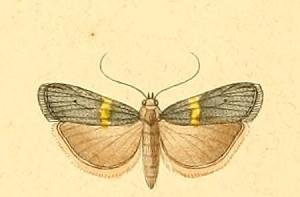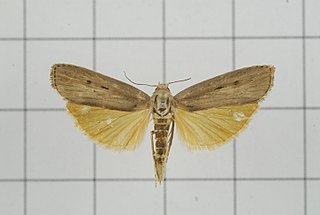
The Pyralidae, commonly called pyralid moths, snout moths or grass moths, are a family of Lepidoptera in the ditrysian superfamily Pyraloidea. In many classifications, the grass moths (Crambidae) are included in the Pyralidae as a subfamily, making the combined group one of the largest families in the Lepidoptera. The latest review by Eugene G. Munroe & Solis, in Kristensen (1999) retains the Crambidae as a full family of Pyraloidea.

The Pyraloidea are a moth superfamily containing about 16,000 described species worldwide, and probably at least as many more remain to be described. They are generally fairly small moths.

Achille Guenée was a French lawyer and entomologist.

Carposinidae, the "fruitworm moths", is a family of insects in the order Lepidoptera. These moths are narrower winged than Copromorphidae, with less rounded forewing tips. Males often have conspicuous patches of scales on either surface. The mouthparts are quite diagnostic, usually with prominent, upcurved "labial palps", the third segment long, and the second segment covered in large scales. Unlike Copromorphidae, the "M2" and sometimes "M1" vein on the hindwings is absent. The relationship of Carposinidae relative to Copromorphidae needs further investigation. It is considered possible that the family is artificial, being nested within Copromorphidae. The Palearctic species have been revised by Alexey Diakonoff (1989).

The Pyralinae are the typical subfamily of snout moths and occur essentially worldwide, in some cases aided by involuntary introduction by humans. They are rather rare in the Americas however, and their diversity in the Australian region is also limited. Altogether, this subfamily includes about 900 described species, but new ones continue to be discovered. Like many of their relatives in the superfamily Pyraloidea, the caterpillar larvae of many Pyralinae – and in some cases even the adults – have evolved the ability to use unusual foods for nutrition; a few of these can become harmful to humans as pests of stored goods.

Ancylolomia is a genus of moths of the family Crambidae described by Jacob Hübner in 1825.

Eudonia is a large and widespread genus in the grass moth family (Crambidae), subfamily Scopariinae. There is no common name for the roughly 250 species placed here; new species are still being described regularly. Although the genus was proposed early in the 19th century already, many of these moths were for a long time retained in Scoparia, the type genus of the subfamily and a close relative of Eudonia. A few small genera have been proposed for separation from Eudonia, but given the size of this group this is not particularly convincing; thus, all are retained here pending a comprehensive phylogenetic review.

Evergestis is a genus of moths of the family Crambidae described by Jacob Hübner in 1825. A number of species are pests, including the cross-striped cabbageworm, a pest of cole crops such as cabbage.
Ancylosis harmoniella is a species of snout moth in the genus Ancylosis. It was described by Ragonot, in 1887 from Spain, Malta, Turkey, Algeria, Morocco, Tunisia, Libya, Egypt, Saudi Arabia, the Palestinian Territories, Syria, Iraq, Iran, Afghanistan and Transcaucasia.

Apomyelois bistriatella is a species of snout moth in the genus Apomyelois. It was described by Hulst in 1887, and is known from California, the eastern United States, northern Europe and Russia.

The Phycitini are a tribe of moths of the family Pyralidae.

The Anerastiini are a tribe of moths of the family Pyralidae.

Isauria dilucidella is a species of moth in the family Pyralidae. It was described by Philogène Auguste Joseph Duponchel in 1836. It is found in most of Europe, Algeria, the United Arab Emirates, Syria, Lebanon, the Palestinian territories, Iraq, Turkmenistan, Mongolia, as well as Georgia, Kazakhstan, Armenia, Turkey, Iran and Afghanistan.

Oxybia is a monotypic snout moth genus described by Hans Rebel in 1901. Its only species, Oxybia transversella, was described by Philogène Auguste Joseph Duponchel in 1836. It is found in southern Europe and on the Canary Islands.

Pyrausta phoenicealis, the perilla leaf moth, is a moth of the family Crambidae described by Jacob Hübner in 1818. It is found worldwide, including the Americas, Africa, Australia and Asia.

Tirathaba mundella, the oil palm bunch moth, is a species of snout moth. It is found in Malaysia.
Cybalomiinae is a subfamily of the lepidopteran family Crambidae. It was described by Marion in 1955.
Glaphyriinae is a subfamily of the lepidopteran family Crambidae. It was described by William Trowbridge Merrifield Forbes in 1923

Scopariinae is a subfamily of the lepidopteran family Crambidae. The subfamily was described by Achille Guenée in 1854.
Eugene G. Munroe was a Canadian entomologist who discovered numerous species of insects. He worked for the Insect Systematics and Biological Control Unit, Entomology Division in Ottawa, Canada.















